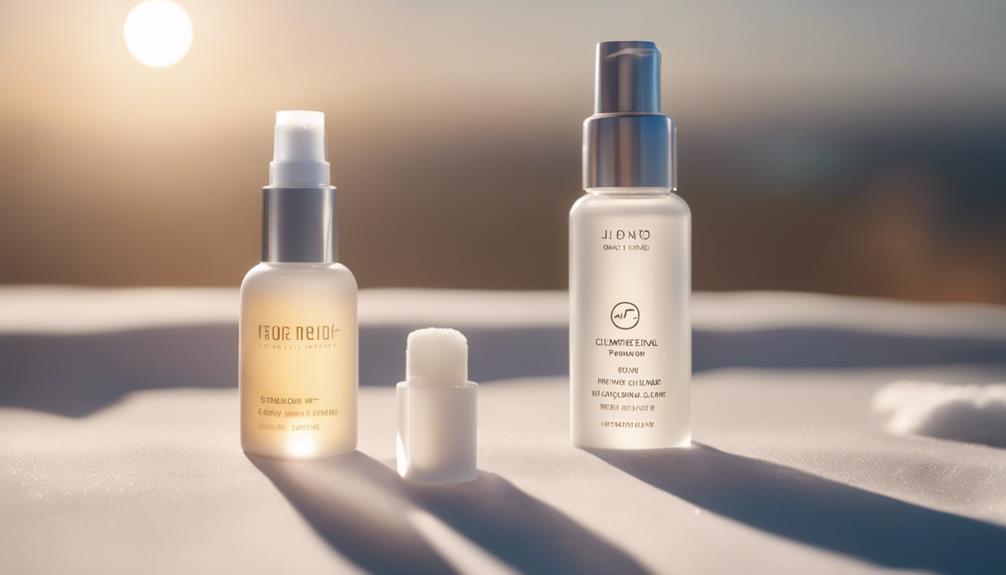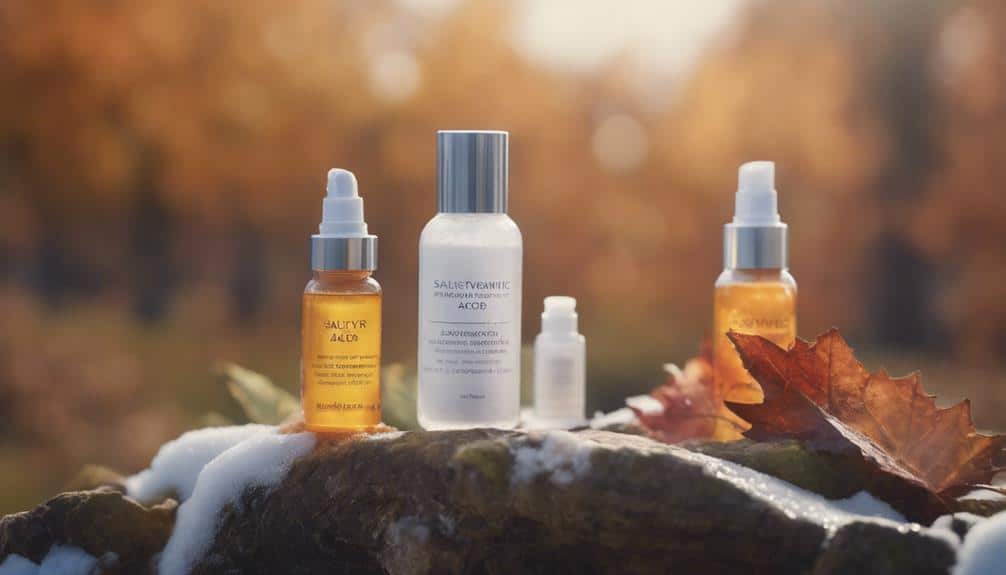When to Use Salicylic Acid in Routine
Picture this: you've just started using salicylic acid because your best friend swears by its magic on their skin, but somehow, your skin isn't singing the same praises. You're left wondering, 'Am I doing this right?' Well, you're not alone.
The key to unlocking salicylic acid's full potential isn't just about slapping it on your face; it's about timing. Should you apply it in the AM to beat the day's grime, or does it work its magic while you sleep? And what about your other skincare steps—where does it fit in?
Stick around, and let's break down the when and how of incorporating this powerhouse ingredient into your routine, ensuring you don't just use it, but you use it right.
Key Takeaways
- Tailor salicylic acid use to morning for oily skin and evening for dry or sensitive skin based on individual skin type.
- Apply salicylic acid post-cleansing to enhance absorption and effectiveness in acne prevention.
- Adjust application frequency and concentration to avoid irritation, especially for sensitive skin or during seasonal changes.
- Incorporate hydration and scar treatment products post-breakout for comprehensive skin recovery and care.
Understanding Salicylic Acid

Before diving into the nitty-gritty, let's chat about what salicylic acid actually is and why it's a game-changer for your skin. You've probably heard buzz about it, right? Well, it's all thanks to its chemical properties.
Salicylic acid, a beta-hydroxy acid, excels at diving deep into your pores. It's like a detox for your skin, breaking down the gunk that leads to those dreaded breakouts. This means it's stellar at acne prevention, keeping those pimples at bay before they even think about crashing your skin party.
Morning or Evening Usage

Deciding whether to add salicylic acid to your morning or evening routine can totally change the skincare game for you. It's all about knowing your skin type and the product formulation you're using. Here's the lowdown:
- Skin type matters: If you've got oily skin, a morning application helps tackle that shine all day. Dry or sensitive? Consider an evening routine to avoid any potential irritation with daytime sun exposure.
- Product formulation is key: Serums and spot treatments? Perfect for nighttime when your skin's in repair mode. Lightweight lotions? They slot right into your morning lineup.
- Balance is everything: Don't overdo it. Listen to your skin's needs and adjust accordingly. You've got this!
Before or After Cleansing

When it comes to incorporating salicylic acid into your skincare routine, figuring out whether to apply it before or after cleansing is a game-changer. Here's the scoop – salicylic acid works best after cleansing.
Why? Cleansing first preps your skin by removing dirt, oil, and makeup, ensuring that nothing blocks this powerhouse ingredient from doing its thing. Plus, applying it to clean skin helps maintain the crucial pH balance necessary for salicylic acid to work effectively.
This step is vital in your product layering sequence, setting the stage for the rest of your skincare products. Think of it as laying down the perfect foundation for your skin's health. So, always remember, cleanse first, then salicylic acid – it's your new mantra for flawless skin.
Prepping for Exfoliation

Now that you've got your cleansing followed by salicylic acid routine down, let's focus on how to ace your skin's prep for the ultimate exfoliation experience. Getting this right is crucial, irrespective of your skin type. Here's how:
- Understand Your Skin Type: Are you oily, dry, combo? Tailoring your approach to your skin's needs enhances the exfoliation process.
- Hydration is Key: Before diving into exfoliation, ensure your skin is well-hydrated. This can't be overstated—hydration is essential for all skin types.
- Test Products: Before going all in, do a patch test. It's trendy to jump onto new products, but let's keep it smart and skin-friendly.
Post-Breakout Care

After your skin has weathered a breakout storm, it's crucial to shift focus to nurturing and repairing the battleground with gentle, effective post-breakout care. You're not alone in this journey back to smooth, clear skin. It's time to bring in the big guns for scar treatment and inflammation reduction, ensuring your skin feels pampered and understood.
Opt for products rich in healing ingredients that fade scars and soothe redness. Remember, your skin's been through a lot, and it's begging for some TLC. Incorporate serums and moisturizers that target these concerns, making them your skin's new best friends.
During Routine Retinol Use

Integrating salicylic acid into your skincare routine can be a game changer, especially if you're already committed to using retinol regularly. But hey, before you dive in, let's get the scoop on how to do it right without causing a skin rebellion.
- Layering Order Matters: Apply retinol first to clean skin at night. Wait a bit, then follow up with salicylic acid. This sequence ensures maximum efficacy without overburdening your skin.
- Timing Is Key: Don't mix them every night. Alternate days or use salicylic acid during retinol breaks to maintain balance.
- Listen to Your Skin: If irritation occurs, dial it back. Your skin's feedback is priceless.
Adjusting for Skin Sensitivity

Considering the steps above, it's crucial to factor in skin sensitivity when adding salicylic acid to your routine. Let's get real, not everyone's skin can handle the same hustle. If your skin throws a tantrum with new products, you're not alone. Here's the deal: maintaining a hydration balance is key. Salicylic acid can be a game-changer, but if your skin's on the sensitive side, it might need extra TLC. Think of hydration as your skin's bestie, keeping things calm and comfy.
Before diving in, why not do a patch test? Allergy tests aren't just for the overly cautious; they're your skin's sneak peek into what's coming. It's like swiping right on a product that could be your skin's soulmate—or not. Listen to your skin; it's got the answers.
Seasonal Considerations

Let's not forget, your skin's needs can change with the seasons, making it vital to tweak your salicylic acid routine accordingly. You're part of a community that's all about smart skincare, so understanding the climate impact and humidity effects is key.
- Winter Woes: Cold, harsh weather can dry out your skin. Consider dialing back on salicylic acid to prevent over-drying.
- Spring into Action: As humidity rises, your skin might be able to handle more frequent applications. It's a great time to ramp up gradually.
- Summer Shine: With increased oil production in hot, humid weather, don't shy away from regular use to keep those pores clear.
Conclusion
Alright, let's wrap this up, gorgeous!
Salicylic acid is your skin's BFF, whether it's AM or PM, but remember, timing is everything. Slide it into your routine post-cleansing and before you unleash the power of exfoliation.
Got a zit? Don't fret, salicylic acid's got your back.
Mixing it with retinol? Go slow, darling.
And hey, your skin's mood swings? Totally normal. Just tweak as the seasons change.
Trust me, you'll be rocking that glow in no time!






